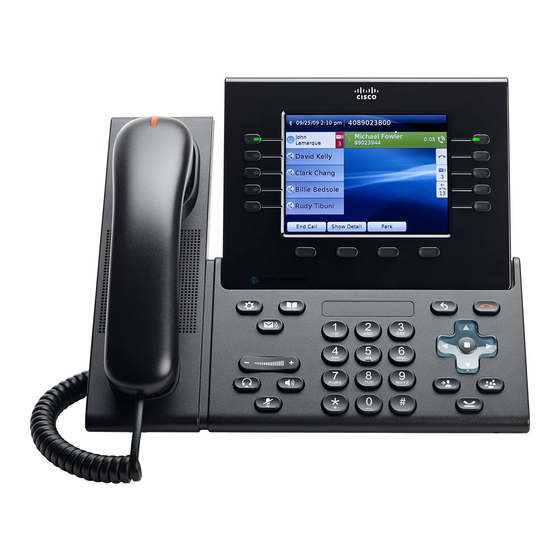
Cisco 8961 Manual
Hide thumbs
Also See for 8961:
- Administration manual (378 pages) ,
- User manual (180 pages) ,
- Features (35 pages)
Table of Contents
Advertisement
Quick Links
1
Phone Screen
2
Session buttons
Shows information about your phone, including directory number (extension), call
information (for example caller ID, icons for an active call or call on hold) and
available softkeys.
Each corresponds with an active call function. Pressing the button takes the default
action:
-
Active calls-Pressing the button takes the default action for an active call. For
example, pressing the button for a ringing call answers the call and pressing
the button on a held call resumes the call. Session information, such as caller
ID and call duration, appears on the phone screen next to the session button.
-
Call functions-When a session button is not being used for an active call, it
can be used to initiate functions on the phone, as indicated by the adjacent
phone screen icons. For example, pressing the session button can display
missed calls, take the phone off hook, or dial your voice-messaging system
(with a voice mail icon).
Color LEDs reflect the call state. LEDs can flash (blink on and off rapidly), pulse
(alternately dim and brighten), or appear solid (glow without interruption)
-
Flashing amber
-
Solid green
connected. If the call is connected, pressing this button displays the call
details for the participants of a conference call. If the call is not yet
connected, pressing this button ends the call.
-
Pulsing green
-
Solid red
-
Pulsing red
resumes the held call.
1
Ringing call. Pressing this button answers the call
May be a connected call or an outgoing call that is not yet
Held call. Pressing this button resumes the held call
Shared line in-use remotely.
Shared line call put on hold remotely. Pressing the button
Advertisement
Table of Contents

Summary of Contents for Cisco 8961
- Page 1 Shows information about your phone, including directory number (extension), call Phone Screen information (for example caller ID, icons for an active call or call on hold) and available softkeys. Each corresponds with an active call function. Pressing the button takes the default action: Active calls-Pressing the button takes the default action for an active call.
- Page 2 Allow you to access the softkey options – phone features (for the selected call Softkey buttons or menu item) displayed on your phone screen. Returns to previous screen or menu. Back button Ends a connected call or session. Release button The four-way Navigation pad allows you to scroll through menus, highlight items, and Navigation pad and Select move within a text input field.
-
Page 3: Phone Screen
Phone Screen The way that your system administrator set up your phone determines what is displayed on your phone screen. Line Label Displays the line phone information Displays the date and time, and information (such as phone number) about the selected Header line. -
Page 4: Call History
Applications button Phone applications allow you to access the following: ► Call History Call History allows you to view information on the last 150 calls on your phone. An icon displays indicating the type of call: ● Received - ● Placed - ●... - Page 5 5. Edit Number From Call History ● Press the Applications button ● Select the Call History. (Use the Navigation pad and Select button to scroll and select.) ● Highlight the call you want to edit. ● Press the EditDial softkey. (you may need to press the More softkey first). ●...
-
Page 6: Answering Calls
►Listen to Voice Messages (see Setting Up Your Cisco Unity Voice Mailbox) 1. To listen to voice messages, do one of the following : ● Press the Messages button ● Select a line with a Message icon , and :... -
Page 7: Transferring A Call Directly To Voice Mail
►Placing A Call On Hold 1. When connected to a call, press the Hold button. (caller hears system “music-on-hold”) 2. To remove a call from hold on the current line, make sure that the appropriate call is highlighted and press Resume softkey or held session button. -
Page 8: Do Not Disturb (Dnd)
The parked call is placed on hold. 2. To retrieve the parked call from another Cisco Unified IP Phone, go to another phone within your location, lift handset and dial the call park number where call is parked, to retrieve the call. -
Page 9: Corporate Directory
►Corporate Directory The corporate directory contains corporate contacts that you can access on your phone. Your system administrator sets up and maintains the directory. Search for and Dial a Contact Press the Contacts button 2. Select the Corporate Directory. (Use the Navigation pad and Select button to scroll and select.) 3. - Page 10 ● Search for an Entry in Personal Directory 1. Press the Contacts button Sign in to Personal Directory (Use the Navigation pad and Select button to scroll and select.) 3. Select Personal Address Book. 4. Select one, all, or none of these criteria to search for an entry: ●...
- Page 11 ● Delete a Fast-Dial Code 1. Press the Contacts button Sign in to Personal Directory. 3. Select Personal Fast Dials and search for a fast-dial code. 4. Select the fast-dial code that you want to delete and press the Remove softkey. (You may need to press the More softkey first) 5.








Need help?
Do you have a question about the 8961 and is the answer not in the manual?
Questions and answers